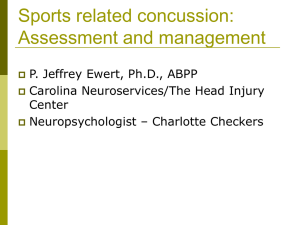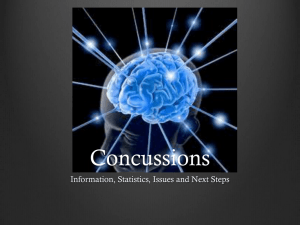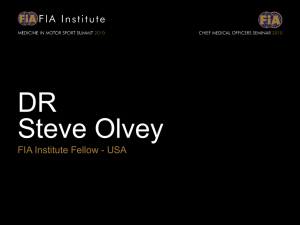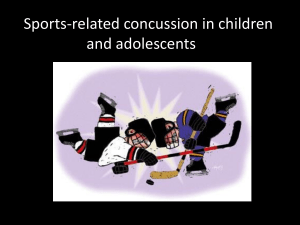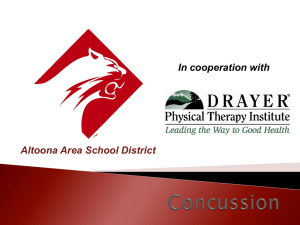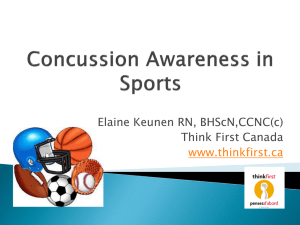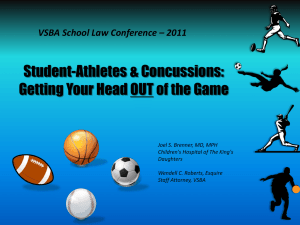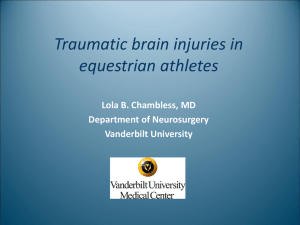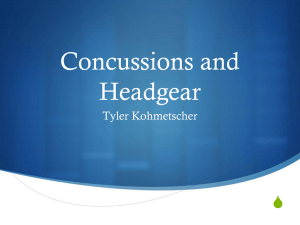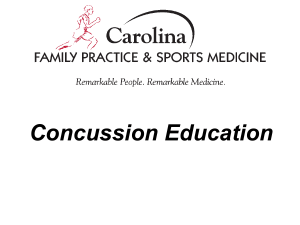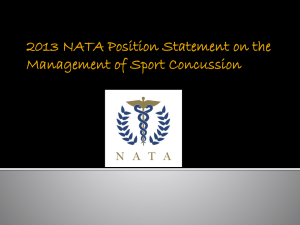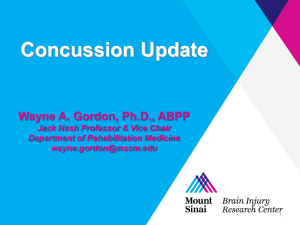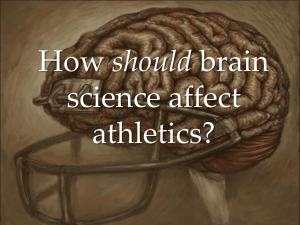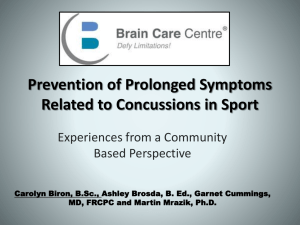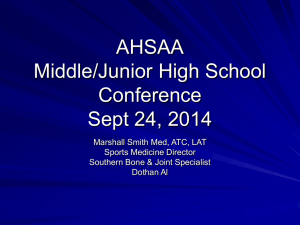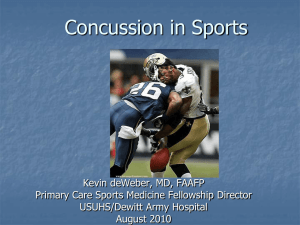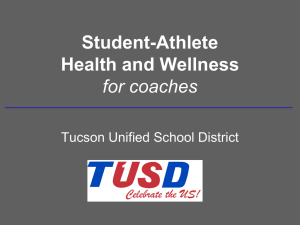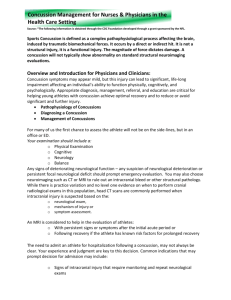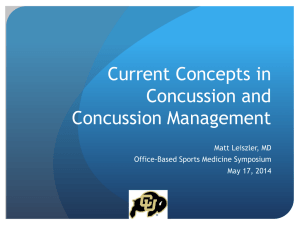Head Injuries
advertisement
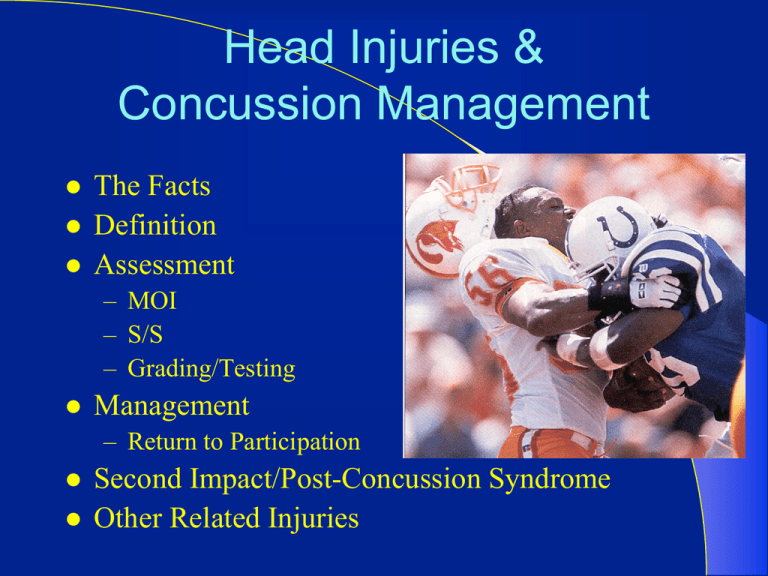
Head Injuries & Concussion Management The Facts Definition Assessment – MOI – S/S – Grading/Testing Management – Return to Participation Second Impact/Post-Concussion Syndrome Other Related Injuries The Facts Concussions can Occur in Any Sport Concussions can be Life Threatening 2-4 million Concussions/Year 10% of all contact sport athletes get concussed each season After 1st Concussion, Chance of 2nd is 4X Greater*** Definition of Concussion A clinical syndrome characterized by immediate and transient post-traumatic impairment of neural functions. In English = Brain trauma that messes up your normal brain function. MTBI: Mild Traumatic Brain Injury Sports Concussion More Concussion Facts Injury appears to be metabolic not structural which is why CT scan is almost always normal Headache probably caused by increased glucose demand following injury Magnitude of force not predictor of outcome/severity of injury – Seems to be an increased risk from force on top of head? Recovery time – Professional < College < Youth NFL vs. Youth FB – Concussion Rate (1 /5650) Sport with highest risk during games? Where to get the best info on Concussions? NATA.org CDC.gov Consensus Statement 3rd Int’l Conference on Concussion in Sport- Zurich 2008 – Clin J Sport Med 19(3), p.185-195 Mechanism of Injury (MOI) Direct (Coup) – Simple Physics Indirect – Blow to Chin – Fall in Sitting Position Contrecoup Injury – Brain Damaged on Opposite Side of Trauma – Head Moving into Stationary Object I think he has a concussion! Signs and Symptoms(S/S) Disorientation Dizziness Headache*** Loss of Consciousness* Nausea Tinnitus Movement/Balance Problems Blurred Vision Nystagmus (Involuntary Eye Movement) Pupil Discrepancies Post-Traumatic (Anterograde) Amnesia (PTA)* Retrograde Amnesia* IC Concussion Management Policy All concussions will be treated and managed on an individual basis If an athlete describes concussion-like S/S, it will be treated as though a concussion has taken place Once concussed, an athlete will not return to the current game or practice The athlete should be given an on-the-field SCAT, and a follow-up IMPACT test once symptom-free Pre-Participation/Baseline Testing All athletes are asked about concussion hx during PPE Any athlete with hx of concussion, along with athletes from the following sports will be baseline tested using IMPACT – Football, Soccer (MW), Field Hockey, Lacrosse (MW), Baseball, Softball, Gymnastics, Wrestling, Basketball(MW) What is IMPACT? A computer based neuropsychological test Assesses memory, reaction time, and cognition Test can be taken on any computer (with a mouse) and takes about 25-30 minutes to complete Demo may be taken at www.impacttestonline.com/impactdemo Immediate Concussion Management On-the-field SCAT (Sport Concussion Assessment Tool) Gross Neural Exam, Other evaluation as needed Athlete is given Sports Concussion information sheet – Given follow-up appt with ATC or team MD – Advised to have complete mental and physical rest – Discuss do’s and don’ts Alcohol, Meds Other Special Tests Four C’s – Cognitive Anterograde vs. Retrograde Counting – Cranial Nerves (12) Eye Tests (PEARL, Vision, Tracking) Facial Movements – Coordination Rhomberg, Finger to Nose, Heel to Toe, Past Pointing – Consciousness Reflex (Babinski) Sensory (Dermatomes) Criteria to Assess for RTP 1) Normal Neurological • Four C’s • • Consciousness, Cranial Nerves, Cognition, Coordination Myotomes/Dermatomes 2) Normal Vasomotor 3) Free of S/S (Headaches, Balance Problems) • “If you Sway, you don’t Play” 4) Increase in Activity doesn’t Cause S/S to Return Return to Play Progression Athletes should be asymptomatic and at/better than baseline on IMPACT before RTP Progressive system of return – Level 1- Rest – Level 2- Light Exercise – Level 3- Sport Specific Exercise – Level 4- Non-Contact Drills – Level 5- Full Contact – Level 6- Game Each level should take approximately 24 hours If s/s resume, drop back to previous level once asymptomatic Some concussions will be progressed much slower, MD controlled Returning after Multiple Concussions Team Physician Decision CT Scan, Other Testing? Possible Consultation with Neuropsychologist – SUNY Upstate Second Impact Syndrome Second Impact Syndrome (SIS) – Athlete returns to play while still experiencing S/S of previous concussion, then receives another blow, causing serious injury/possible death – Typically seen in adolescent athletes – Concussions are Cumulative!! – DON’T Push for Early Return to Play. – Problems: Little or no research on youth, parents think – CT scan means OK, youth athletes not as honest Post-Concussion Syndrome Continued disability due to one or more concussions. Examples with Professional Athletes: – Al Toon, Meryl Hoge, Chris Miller, Brett/EricLindros, Pat LaFontaine, Stan Humphries, Steve Young, Troy Aikman Three Categories of S/S – Physical: Headache, Dizziness, Light Sensitive – Emotional: Anxiety, Depression, Anger – Cognitive: Attention, Memory Possible Related Injuries Subdural Hematoma Epidural Hematoma Skull Fracture Cervical Spine Injury Subdural Hematoma Slow Venous Bleeding (Subdural Space) Symptoms Progressively get Worse – Hours to Days Increased BP, Decreased Pulse, One Pupil Dilated, Muscle Weakness on Opposite Side of Injury Epidural Hematoma Arterial Bleeding – High Pressure (between Skull and Brain) Rapid Deterioration – Minutes to Hours Similar S/S to Subdural, also Sleepiness, Convulsions Skull/C-Spine Trauma Skull Fracture – R/O Fx at Trauma Site or Away from Site – General S/S: Skin Cool and Moist, Decreased BP/Increased Pulse, and Pupil Discrepancies – Specific S/S: ‘Raccoon Eyes’, ‘Battle’s Sign’, Goose Egg, Cerebrospinal Fluid (CSF), Otorrhea/Rhinorrhea – Testing for CSF Discharge Bull’s Eye Test/Halo Sign – Pale Yellow CSF Encircles Blood Sample Cervical Spine Injury – Point Tender, Numbness/Tingling, Inability to Move Limbs Summary Monitor ABC’s, Recognize Concussion History – What happened?, Previous Hx, Neck Pain, LOC?, Who are you? Where are you? Observation – Focus, Balance, Pupils, Bleeding/CSF (Halo Sign), Trauma Signs, Verbal Ability Palpation – Skull, Cervical Spine, Mandible, Eye Socket Special Tests, SCAT, IMPACT Refer, Information Sheet, F/U



